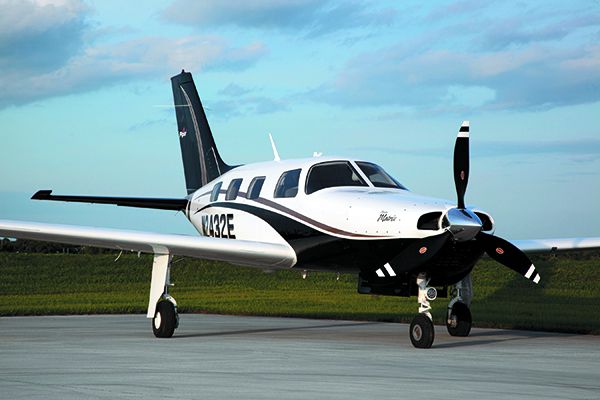For many pilots, Piper’s PA-46 series, which includes the Malibu, Mirage and Matrix (and current M300 series), could very we’ll be the ultimate step-up piston single. Get it up high and the airplane can do an honest 200 knots in pressurized comfort (the simpler Matrix is non-pressurized). It’s also a good IFR airplane thanks to sturdy handling that’s more SUV-like than sports car, plus it just looks sexy on the ramp.
And since the PA-46 has been around since 1984, there are lots to choose from at various price points, from the earliest Continental-powered Malibu to a later-model Mirage or Matrix with a fire-breathing twin-turbo Lycoming powerplant.
Still, PA-46 ownership isn’t for everyone. These airplanes—no matter the vintage—are far from inexpensive to own and operate, and insurance companies know that they are unforgiving in the hands of pilots who don’t take training seriously. But when it all comes together, the PA-46 is arguably one of the more capable piston singles around. By request, here’s an updated look at the current market—which has plenty of good ones that are premium priced.
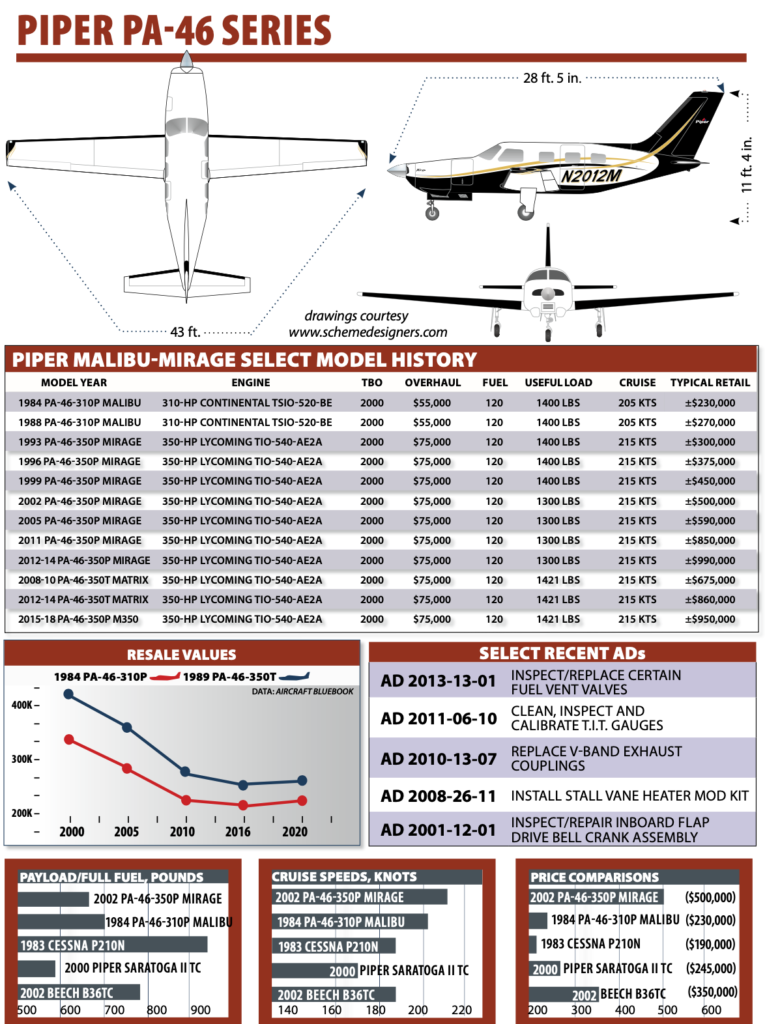
THE BEGINNING
Flash back to somewhere around 1982 when the Piper Malibu prototype emerged from the company’s Vero Beach plant. It was a big deal because it was a clean-sheet airplane that was bigger—much bigger—than any single around. Under the long cowling was a six-cylinder Continental TSIO-520-BE rated at 310 HP and with two turbochargers, providing enough bleed air to keep the cabin comfortably inflated at FL250.
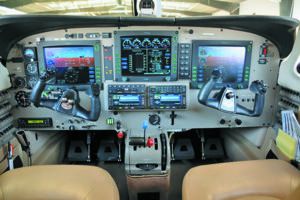
The Malibu’s base price was $275,000, but with options the typical price was more than $320,000, or around $800,000 in 2020 dollars. Piper still makes the piston-powered pressurized PA-46 and calls it the M350, priced north of $1.1 million.
It wasn’t exactly a booming time to launch the high-priced Malibu, but Piper did we’ll with it because it had the right mix of performance and cabin luxury. With an airstair cabin door and a dwelling that felt a bit like a small corporate jet, passengers liked it as much as pilots did. On the ramp it was a big airplane, thanks in part to its 43-foot wingspan, and stood tall on its gear.
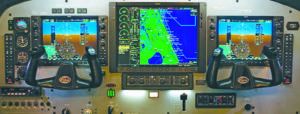
For an airplane of the Malibu’s ambitious leanings, the correct engine is a must. But early on, Piper never seemed able to find the right powerplant. From the beginning, it was thought that buyers favored a Lycoming because of a perceived reputation for reliability and robustness. The would-be owners turned out to be correct. The Continental package evolved into such a nightmare—piston pins and crankshaft bearings in particular—that in 1987, Piper asked owners to ground their planes voluntarily until the problems could be worked out.
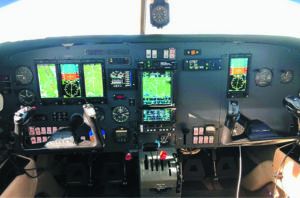
As is often the case, the production airplane was heavier than intended, but this was offset by a boost in takeoff weight. Useful load worked out to be 80 pounds less than planned; not a deal breaker, but a weight equivalent to fuel for IFR reserves.
Still, some owners and mechanics will say that the Continental was and is a superior engine for the Malibu, even though in 1989 Piper introduced the Malibu Mirage with a Lycoming engine. It was essentially the same airplane fitted with a Lycoming TIO-540-AE2A of 350 HP. The new engine weighed 113 pounds more, but the maximum takeoff weight was boosted by 200 pounds. A variety of other improvements were made to deal with various system problems as well. There were some growing pains, to say the least.
The complex nosegear, which rotates 90 degrees to fit into its bay, proved delicate. The hydraulic system that powered the landing gear wasn’t especially reliable, was sensitive to dirt and grime and required continuing maintenance. The hydraulics also ran the flaps on early models. To make the airplane appealing to what Piper thought was its core market, the company called for exceptional range we’ll beyond the fuel specifics of most six-cylinder engines. Continental thus specified operating requirements for the engine that were unusual at the time, specifically lean-of-peak EGT operation.
To beat down the fuel flow, Continental required pilots to lean the engine to 50 degrees lean of peak for all operations below 80 percent power, which is the maximum recommended cruise setting. That went against what most pilots had been taught before the current understanding of lean-of-peak ops—and a fair number ignored the instructions and ran rich of peak.
Whoever was to blame for Malibu engine problems, squabbles between owners, Piper and TCM grew heated and ugly at times. The irony is that the fixes applied to the Continental made it as good as the Lycoming installation. Both are sensitive to proper operating technique. The lack of cowl flaps doesn’t help matters. The engines in these airplanes simply run hot. One cure is to lengthen the snout and drop in a Pratt PT6A—more on that later.
LYCOMING NIGHTMARE
Owners of early Mirages suffered through Lycoming’s massive crankshaft recall of 2002 and 2003 and weeks to months of downtime. The perceived reliability of the Mirage got so bad among some owners that a class-action lawsuit was filed in 2000 against New Piper and Lycoming. The suit was settled after the court failed to certify the class.
Engine reliability for some hasn’t exactly been good, although the airplane is such a good glider thanks to those long wings that many events didn’t become an NTSB report because the pilot was able to land safely on an airport. Our most recent survey of accidents showed that 21 percent were engine-related—a pattern that’s consistent.
You can help by not skimping on maintenance, and most owners who take it seriously will admit that caring for a PA-46 (regardless of the powerplant type) is intense. Alternators, vacuum pumps and, in particular, the exhaust system are all items mentioned by our survey respondents and matched the Service Difficulty Reports reported to the FAA.
What we did see is that things have improved over the years. Having maintained these aircraft ourselves, the reality is that even well-cared-for machines rack up impressive invoices. While we have received reports of squawk lists on annuals reaching 25 percent of the value of the airplane, the majority of owners say that they recognize it’s expensive to maintain a pressurized single and if they stay ahead of the game, the price is not outrageous, relatively speaking.
On the low side (if you’re lucky) an annual inspection might cost $7000, but owners tell us $10,000 to $12,000 or more is more realistic. In our view, you’ll play it safe by figuring you’ll fly away paying closer to $10,000 for a thorough inspection, if you’ve been addressing minor routine squawks along the way. Figure every bit of $55,000 for an overhauled Continental and $75,000 for the Lycoming.
The PA-46 nosegear is tender and the hydraulic system continues to pose problems. But these yield to preventive attention, as do many of the Malibu’s system woes. Even ardent supporters of the airplane admit that it requires frequent and ongoing maintenance. Owners emphasize the value of having a knowledgeable maintenance shop doing routine and ongoing work on the airplane. The Malibu is not an airplane that just any shop can fix and we don’t recommend bringing one to a shop without PA-46 experience.
But owners really like their airplanes. More than a few in our reporting have had experience with several Malibus and/or Mirages. Is one better than the other in terms of maintenance? Our impression is that they’re about the same and that any owner contemplating buying a PA-46 should simply budget a pile of cash for annual maintenance and fix stuff as it breaks. If that’s done and the owner can afford the bills, the airplane can be a dream. As our recent owner feedback shows, many Malibu and Mirage owners have held on to their aircraft for many years.
THE LATER YEARS: MIRAGE AND MATRIX
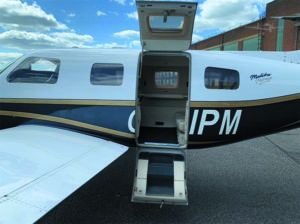
When Piper introduced the Mirage, some of the problematic systems were addressed. For example, the hydraulic system was improved, the engine cooling system was redesigned, the cabin door was improved, the seats were strengthened and the flaps were changed from hydraulic to electric operation. (Actually, some of the later Malibu models got the electric flaps and improved hydraulics for the gear.)
The Mirage also got some big-airplane-type features that owners appreciate, including a dual-bus electrical system, internal windshield deice, standard dual alternators and vacuum pumps and an auxiliary heater for the cabin. It needed it. It’s cold back there in the flight levels, even during the summer. Again, some of these mods appeared on later Malibus.
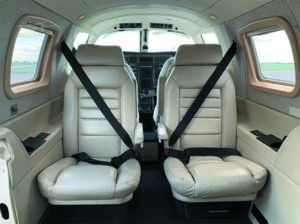
As expected, the later Mirage eventually got Garmin’s G1000 integrated avionics to replace Avidyne’s Entegra suite, which also included Garmin GPS navigators and the rate-based S-TEC 55X autopilot—a system poorly matched to the PA-46 speed and performance envelope.
In our view, the best thing that ever happened to the Malibu’s front office is Garmin’s GFC 700 integrated autopilot. Aside from its advanced features, it finally gave the airplane the tight autopilot performance it deserves, especially on coupled approaches.
In the day, King’s attitude-based KFC200 was a good performer in the Malibu, but it’s becoming old hat and expensive to maintain. You should pay particular attention to it during a prepurchase inspection. Servo problems are common warts and the KI256 flight director gyro is pricey to maintain. Some versions aren’t supported at all. We suggest finding one that’s had a glass upgrade.
Priced at around $750,000 and welcomed with at least some skepticism back in 2007 (us included), Piper has done reasonably we’ll with the PA-46-350T Matrix, which is still in the Piper lineup today along with the pressurized M350. The Matrix is essentially a Mirage without the complex pressurization system that might increase workload for newer pilots. Plus, removing all of the pressurization hardware from the airframe bumps the useful load up to 1421 pounds, while fuel capacity remains the same.
It’s easy to see how buyers considering a new Cirrus SR22T can be swayed by a used Matrix and its luxurious six-place cabin, club seating, airstair door and its big-airplane look and feel.
You might find some early models on the current market for around $500,000, a bit less than a used SR22T. A 2011 Mirage has an Aircraft Bluebook suggested list price of $830,000. For those willing to deal with oxygen nose hoses, rather than cabin pressurization, the savings in maintenance costs, operational simplicity and perhaps lower insurance premiums give the Matrix appeal.
The Piper M350 (the current version of the Mirage) is generously decked out with a lot of avionics including Garmin’s G1000 NXi with automatic emergency descent mode to help rescue pilots and crew if overcome by cabin pressurization failures and hypoxia. Older Malibus might have a variety of retrofit gear.
CABIN DWELLING
Piper salespeople always boasted that the PA-46 is a true six-place airplane with cabin-class comfort. That’s mostly true, but these airplanes don’t have standup cabins. The airplane’s front office isn’t exactly cavernous, either. Getting into the seats requires minor contortions through a narrow aisle between bulkheads walling off the rear cabin. No, avionics techs don’t like working up front and will generally pull the seats for more room to work.
Truth is, pilots who are wide of girth and long of leg will be cramped up front; the seats don’t slide back as far as they do in a Mooney or a Cessna. Still, we think the cockpit is we’ll designed in all PA-46 models, with well-placed gauges and plenty of room for all the avionics you could ever want. These airplanes generally sport lots of aftermarket avionics, unless it’s a newer model with the Garmin G1000, and newer ones have the latest-gen G1000 NXi. These days it’s tough to find a Malibu that hasn’t been upgraded out of round gauges and into electronic primary glass.
Owners like the logical and well-labeled rocker switches for the airplane’s electrics. Later models have overhead switches that are a challenge for the presbyopic set and concern us from a crashworthiness standpoint. You don’t want to hit your head on that panel in a crash.
The cabin arrangement is superb, with the Mirage somewhat better
than the original Malibu. The airstair door is a plus, making for relatively easy entry and egress.
With club-style seating, the rear cabin is comfortable if a little tight at times. Rear-seat passengers complain about too little heat—fixed with the aux heater—but the air conditioning/pressurization system is quite good, when it isn’t broken. Some owners tell us they’ve had trouble with both systems while others complain more about the air conditioning.
Cabin and cockpit noise are on the low side as GA airplanes go. The Continental in the Malibu is noticeably less vibey than the Lycoming in the Mirage, based on the ones we have flown.
Like most airplanes, the Malibu is not a fill-the-seats-and-tanks six- seater. But it will comfortably carry four people and baggage with full tanks, yielding a nonstop range of about 1400 miles for the Malibu and 1000 to 1200 miles for the Mirage. Typical useful loads are 1400 pounds and 1300 pounds, respectively.
Baggage space is generous, with two baggage bays, one just aft of the engine compartment and the other behind the rear seats, making loading within limits easier. Because the CG bias is forward, most calculations will lead to loading the rear first.
The Mirage’s Lycoming engine is larger and the accessory layout is different, so the forward baggage bay in the Mirage is a bit smaller than that of the Malibu. The inclusion of an access panel in the firewall is a good tradeoff, since it makes it much easier to get at the backside of the powerplant.
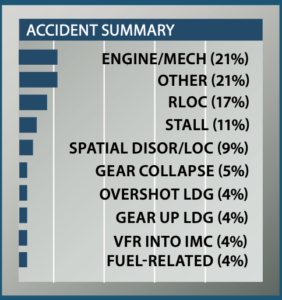
When we last researched 100 Piper PA-46 accidents, we were pleased to find that the accident rate was low enough that we had to go back to the last year of the last century, 2000, to find the full 100 mishaps. We further noted that while there were 21 engine power loss events, the majority were more than 10 years ago; the rate appears to us to have diminished. That was also the case with gear collapse incidents, almost all of which were more than 10 years ago.
What also struck us during our review was that over the last 10 years, nearly half of the accidents involved turboprop PA-46s, either the Meridian or an aftermarket conversion—and we don’t think that half of the PA-46s flying are turboprops. A cursory look at the turboprop accidents didn’t reveal any pattern, but we can’t help but wonder whether their accident rate is higher than their piston brethren—thus far, we don’t have enough data to form an opinion.
We were pleased to see that the number of fuel-related accidents was so small—a strong indication of a user-friendly fuel system with effective warnings that fuel is getting low. Of the four accidents, only one involved fuel exhaustion. Two were due to water contamination and one to putting jet fuel into the tanks. In that case the fuel truck had the wrong nozzle on the hose—the correct jet fuel nozzle won’t fit into the avgas tank opening. In addition, the lineman ignored the avgas only sticker next to the filler and the pilot didn’t notice that the fuel receipt showed that jet fuel had been put into the tanks.
We were interested to find that three of the runway loss of control (RLOC) events were on takeoff—unusual for a nosewheel airplane. PA-46 pilots did demonstrate some difficulties controlling the machine on rollout after landing in crosswinds—which surprised us as the wide-track gear should make for good ground handling. To our amazement, three pilots were going so fast down final that when they tried to force the airplane onto the ground they hit the prop.
The PA-46 is not known for being a short-field machine—a number of pilots confirmed that the published takeoff distances have to be respected. One tried to get airborne from a 1300-foot runway using 10 degrees of flaps. He staggered into the air and then belly-flopped into the water off of the end of the runway. He claimed the engine lost power. Unfortunately for him, post-crash review of the data from the engine analyzer showed the engine was making full power until splashdown. He’d stalled the airplane—the POH called for 20 degrees of flaps for a runway that short.
Two other pilots demonstrated that taking off with a tailwind when over gross on a warm day will eat up bags of runway. One ran off the end of a 5800-foot-long runway. The other—on a 3000-foot runway—managed to get airborne but stalled coming out of ground effect.
We saw no indication that PA-46s are more allergic to ice than any other airplanes, but a pilot who didn’t remove the snow from his wings barely staggered off of a 4500-foot runway before crashing into gently rising terrain. Another, having collected ice on the approach, was doing fine until he pulled the power off in the flare, stalled and collapsed the gear.
PERFORMANCE, HANDLING
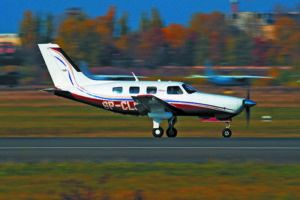
Malibu performance puts the airplane in a category with many twin-engine airplanes but on less fuel. Malibu pilots report cruise speeds of 205 knots TAS at FL220 at 67 percent power and 210 knots true at FL250 at 75 percent.
Mirage pilots pay more at the gas pumps but in exchange, they go a little faster, with speeds typically of 220 knots at FL230-250 at 75 percent power burning 18.8 GPH.
Owners of both models say they can fly 1100-nautical-mile trips with IFR reserves. But we have our doubts about the fuel-guzzling Mirage matching range with the Malibu in real-world conditions. The power setting and leaning would have to be right. The -310P, with its lower fuel consumption—as much as 4 to 5 GPH when flown by the book—has nearly 25 percent better range and is only about 5 percent slower. One owner cited this as the reason he chose the Malibu over the Mirage.
On trips of any length, most owners climb rapidly into at least the high teens, but the airplane is perfectly at home up to FL250. One place it’s not at home is taking off from short runways. Initial acceleration is sluggish, although the airplane will get in and out of 3000-foot strips at sea level with relative ease. We would be sure to be on the game while operating out of 2500 feet or less.
How about handling? Does it match the airplane’s sexy looks? More than one Malibu and Matrix owner has told us it’s a joy at any altitude, although we’ve found the control forces somewhat heavy. We’ve always felt that the PA-46 is an autopilot airplane.
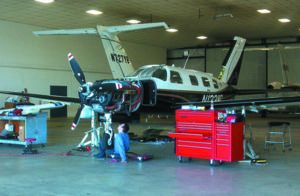
For hand flying, we’re not talking Bonanza handling here but the controls are responsive, with pitch the lightest and roll the heaviest. The PA-46’s long, high-aspect-ratio wing is good for climb and high-altitude performance, but along with it comes a low maneuvering speed in the mid-130s KIAS at gross, decreasing as the airplane gets lighter.
The long wings produce another undesirable trait: The roll rate at slow speeds is somewhat ponderous compared to other singles. Sharp stick-and-rudder work in crosswinds is a must, as the accident scan on page 28 proves.
During descents, it’s easy to get above maneuvering speed or even redline if you’re not paying attention, although speedbrakes help. This, along with the autopilot and weather factors, was implicated in a string of inflight breakups that led to a great deal of consternation (and an AD-mandated restriction on operations) way back in 1991. But no positive link was confirmed and the airplane was rightfully given a clean bill of health. There was a lesson.
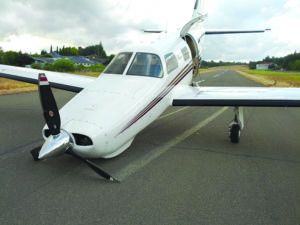
Speed control is a must. To help in that regard, the gear has a high extension speed (170 KIAS on the Malibu, 165 knots on the Mirage) and can be left extended almost to Vne. We’ve done it in a rapid descent. Yes, it’s uncomfortable.
The first notch of flaps can be extended at the same time as the gear. Pilots report that the gear makes an effective speedbrake. Retraction speed is much lower, at 130 knots (Malibu) and 126 knots (Mirage) KIAS.
The wreck reports show that many PA-46 crunches occur during landing. There isn’t anything particularly difficult about landing a PA-46, but the long wing encourages floating and when lightly loaded, the CG is forward. These two characteristics sometimes lead to abuse of the relatively delicate nosegear. Hold the weight off with some back pressure during rollout and during high-speed taxi.
CURRENT MARKET, TURBINE MOD, SUPPORT
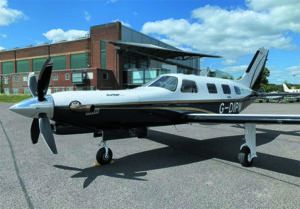
The PA-46 is we’ll supported by one of the best owner groups in general aviation, the Malibu/Mirage Owners and Pilots Association found at www.mmopa.com. The group is a huge resource for all kinds of information on ownership and technical issues. Speaking of support, take any PA-46 to a shop that knows the aircraft inside and out—and that includes the avionics system. This is even more important for pressurized models.
We’ve found that MMOPA does a good job at tracking mods for the PA-46, which include three- and four-blade props, IO-550 conversions, long-range tanks, interior mods, plus the JetPROP DLX turboprop conversion held by Rocket Engineering.
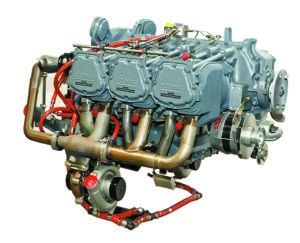
Equipped with a 3600-hour TBO Pratt & Whitney PT6A-35 or -21 engine, the company claims a 900- to 1100-NM range at speeds up to 270 knots true on 33 GPH fuel burn. With a Hartzell or MT four-blade reversing propeller, landing distance is reduced to nearly 1000 feet.
We’ve seen nearly 3000 FPM climb rates on DLX conversions we’ve flown. The company also does avionics upgrades to older models.
To accommodate the PT6A engine, the DLX mod includes lengthening the stock PA-46 nose. The resulting forward baggage area is an impressive 33 cubic feet. Contact Rocket Engineering at www.jetprop.com. The company is based in Spokane, Washington.
Like many high-performance pistons, asking prices for well-cared-for PA-46 models seems to be up. We scoured the used market starting with the respected Controller.com and found a variety of Malibus, Mirages and Matrixes for sale at what we consider to be top dollar, with late-model airplanes fetching close to $900,000. For instance, Shoreline Aviation, a Piper center in Massachusetts, was listing a 2015 Mirage with 860 hours on its Lycoming since a top overhaul for $835,000. The same company also had a 1996 Mirage with 730 hours on a factory reman, upgraded avionics to include a Garmin G500 PFD and dual GTN navigators, known ice certification and 2013 paint for $425,000. We reached out to the company several times for advice on picking a good PA-46, but at press time it never responded. The used Malibu business must be really good.
Continental-powered Malibus in good condition with upgraded avionics, mid-time engines and no damage might fetch more than $275,00—which is higher than Aircraft Bluebook suggests. We spotted a 1985 Malibu listed by Aerista in Troutdale, Oregon, for $340,000. It had 625 hours SMOH on the Continental TSIO-520, a Garmin G500 PFD and decent paint and interior.
OWNER FEEDBACK
I have a Garmin G1000-equipped Piper Mirage, which is typically equipped with FIKI ice protection, TAWS, traffic and a single transponder and has an empty weight of 3130 pounds. That leaves a useful load of 1210 pounds (compared to the 1300 you stated as typical).
The book power settings are bogus. Even Lycoming recommends a 65 percent power setting for cruise that is 100 degrees ROP and not to exceed 1650 degrees TIT. For me, this results in a fuel flow of 20.5 GPH compared to the 18 GPH in the book. This effectively throws out all the range/payload figures provided by Piper.
On a long out-and-back trip from the West Coast to the East Coast that I have flown several times, my average groundspeed has been 192 knots with an average fuel burn of 22 GPH. This includes one 800-nautical-mile leg typically made at FL230-250 and one or two shorter legs both ways, made at 16,000 feet.
Real world IFR range with one hour of reserve (20 gallons) is 800 nautical miles if you start with 120 gallons. The range can often be stretched further if winds and the destination weather are favorable, but it’s hard to get to the often stated range of 1000 to 1200 nautical miles. With 120 gallons on board, I have a payload of 490 pounds.
Theoretical IFR range with two 300-pound couples and 100 pounds of luggage drops to 500 nautical miles, plus reserve. Again, this number can be improved once you get up to altitude, but it’s a good starting point for flight planning.
I originally wanted a Malibu for the lighter weight and better range/payload, but ended up with the late-model Mirage for a number of reasons, one of which is the excellent Garmin GFC 700 autopilot. It flies the aircraft like a dream and the decreased range/payload hasn’t been too much of an issue
I typically fly at 16,000 to 19,000 feet for shorter trips. I made a recent trip across the Pacific Northwest and back—twice in the same day with light winds—and had an average block speed of 167 knots over four 260-nautical-mile legs with vectoring in Class B airspace on one end. Unfortunately, I did not keep track of the overall fuel that day.
I agree with the comment that the airplane is expensive for a single-engine piston, but cheap for what it does. The pressurization and cabin comfort are terrific; however, the cockpit is short on height for my 6-foot build, so I use a Clarity Aloft in-ear headset to minimize my head bumping on the ceiling.
Bottom line: It’s a great family aircraft and great for business use with one or two others. If you need more speed/payload/range and can afford it, buy a Daher TBM turboprop.
Matt Hanson – Spokane, Washington

